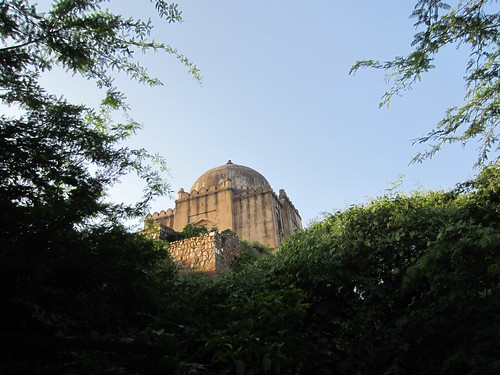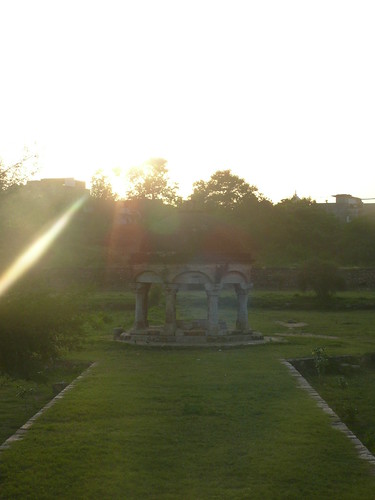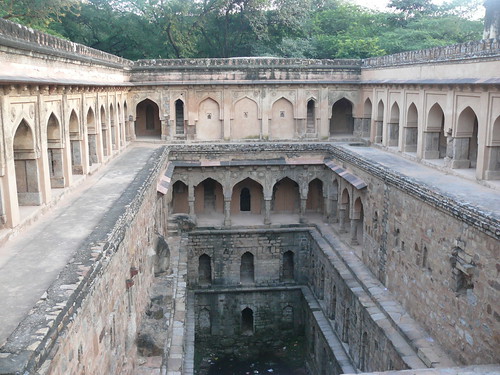Finally. Finally I am starting to go our and see a bit of Delhi. Or at least I've made a start. I'm not sure I can say I'm finally starting if I don't see anything new in the next few weeks, but at least I've succeeded once. Saturday afternoon I joined a group of friends from school to go on a walking tour with Surekha who runs monthly walks around different areas of the city. This month was in the area surrounding the Qutb Minar, a 72 meter tall minaret built between 1211 and 1236. To the south is Mehrauli Archaeological Park, a lush oasis in the middle of the city filled with remnants of building from the Mughal empire.
However, that is not where we started. On the walk towards the park we took a slight detour to climb up to Azim Khan's Tomb. The renovation has just recently been finished and while there is some debate as to if it is the tomb of a general or the son of one of (Mughal Emperor) Akbar's wet nurses it is a pretty little place amid a block of green that provides nice views of the city...and a giant Buddha statue across the way.
Back down to the street we went to head to Mehrauli. I was constantly amazed that we didn't have to get very far away from the busy Delhi streets to end up surrounded in a quiet green growth. We walked over to what had, at one time, been quite a little estate. Across the bridge spanning a canal, then on to look at the boat house which now just overlooked a cluster of plants. Turn around to find a steep series of steps leading up to what is sometimes called Metcalfe's Folly. Originally it was the tomb of Mohammad Quli Khan (brother to one of Akbar's foster brother). In the early 1800s Sir Thomas Theophilus Metcalfe, British resident at the Mughal Court, decided to convert it into his summer residence. Yes, the tomb itself was turned into the dining room of his house with some wings added on to finish it up.
From there we went on to what was probably my favorite sight, the Rajon ki Bain boali or step well. A four level well built in 1506, which provided access to water at every level step wells often gathered small communities around their edges in the covered wings. We then continued to wind our way through the park as the sun started to set. Taking quick glimpses at small ruins along the way, including Balban's tomb dating back to the 13th century (Slave dynasty ruler of Delhi Sutanate), a pavillion with scrafitti on the ceiling (a term I had never heard before but referring to some kind of scratched in artwork), and a crumbling tomb of a Sufi saint that has been forgotten.
The final stop on tour was the Jamali Kamali tomb. Our guide wanted to save the best for last, unfortunately that meant we arrived after dark and my best view of the tomb came when I was looking at my pictures on the computer the next day. It really was unfortunate as our guide actually had to get someone to unlock the tomb so that we could see inside. This tomb containing Jamali (Sufi Saint and poet Shaikh Fazlu’llah) and Kamali (an unknown male companion) dates from around 1535 and has recently been renovated by the Archaeological Society. It is locked up in fear of people coming in and defacing the painted ceiling, ornate decorations or marble mihrab.
By the time we finished there it was dark and we carefully picked our way back to the street to jump in a rickshaw to head to dinner. I'm glad I took a few hours out of my day to get out and see a little bit of the history that Delhi holds. Now the question is, what next?
However, that is not where we started. On the walk towards the park we took a slight detour to climb up to Azim Khan's Tomb. The renovation has just recently been finished and while there is some debate as to if it is the tomb of a general or the son of one of (Mughal Emperor) Akbar's wet nurses it is a pretty little place amid a block of green that provides nice views of the city...and a giant Buddha statue across the way.
Back down to the street we went to head to Mehrauli. I was constantly amazed that we didn't have to get very far away from the busy Delhi streets to end up surrounded in a quiet green growth. We walked over to what had, at one time, been quite a little estate. Across the bridge spanning a canal, then on to look at the boat house which now just overlooked a cluster of plants. Turn around to find a steep series of steps leading up to what is sometimes called Metcalfe's Folly. Originally it was the tomb of Mohammad Quli Khan (brother to one of Akbar's foster brother). In the early 1800s Sir Thomas Theophilus Metcalfe, British resident at the Mughal Court, decided to convert it into his summer residence. Yes, the tomb itself was turned into the dining room of his house with some wings added on to finish it up.
From there we went on to what was probably my favorite sight, the Rajon ki Bain boali or step well. A four level well built in 1506, which provided access to water at every level step wells often gathered small communities around their edges in the covered wings. We then continued to wind our way through the park as the sun started to set. Taking quick glimpses at small ruins along the way, including Balban's tomb dating back to the 13th century (Slave dynasty ruler of Delhi Sutanate), a pavillion with scrafitti on the ceiling (a term I had never heard before but referring to some kind of scratched in artwork), and a crumbling tomb of a Sufi saint that has been forgotten.
The final stop on tour was the Jamali Kamali tomb. Our guide wanted to save the best for last, unfortunately that meant we arrived after dark and my best view of the tomb came when I was looking at my pictures on the computer the next day. It really was unfortunate as our guide actually had to get someone to unlock the tomb so that we could see inside. This tomb containing Jamali (Sufi Saint and poet Shaikh Fazlu’llah) and Kamali (an unknown male companion) dates from around 1535 and has recently been renovated by the Archaeological Society. It is locked up in fear of people coming in and defacing the painted ceiling, ornate decorations or marble mihrab.
By the time we finished there it was dark and we carefully picked our way back to the street to jump in a rickshaw to head to dinner. I'm glad I took a few hours out of my day to get out and see a little bit of the history that Delhi holds. Now the question is, what next?




No comments:
Post a Comment